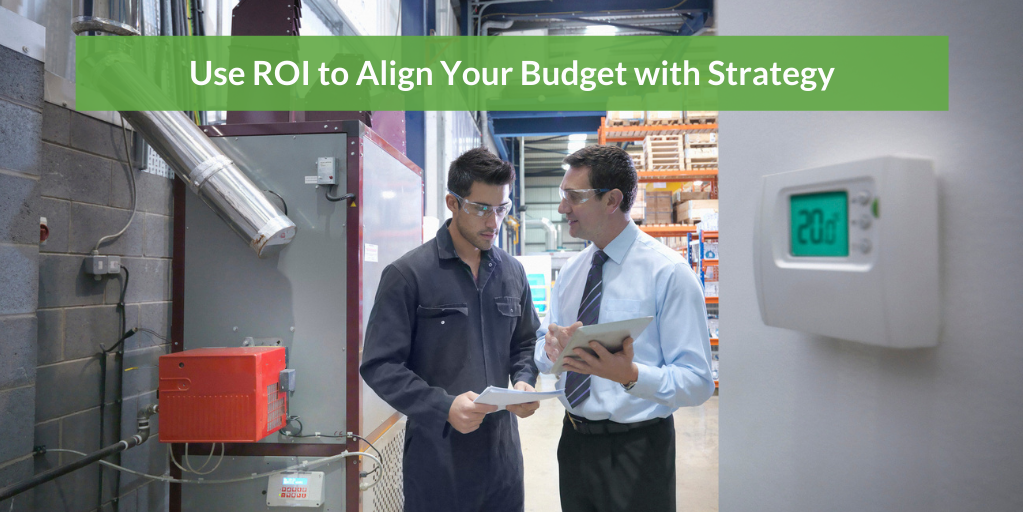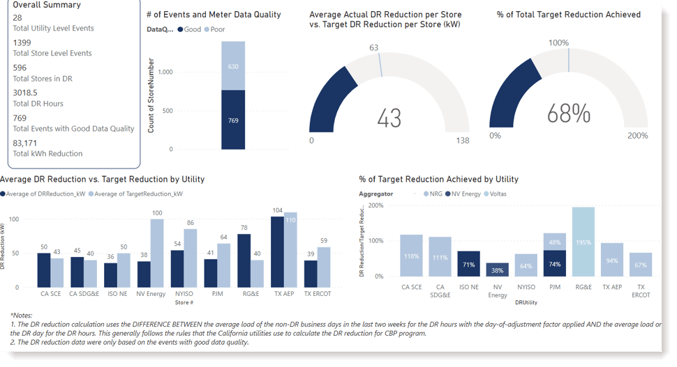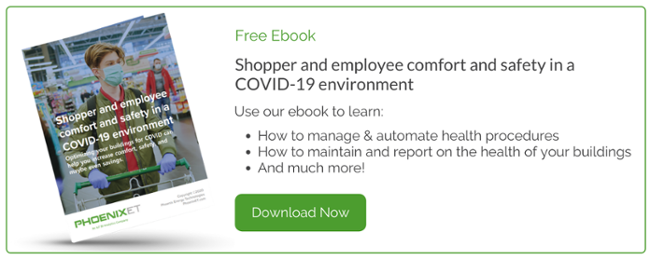Share this
Use ROI to Align Your Budget with Strategy
by Phoenix Energy Technologies on Sep 13, 2021

Facility and energy managers often dread the onset of budget season. As spring approaches, they are calculating expenditures for fall. They move from project planning to spend allocation for new equipment, upgrades, and maintenance—and then must implement those projects before heading into another budgeting cycle. This post offers tips to help get you through the process more successfully.
Budget proposals that resonate with management
The process of projecting needs for the next fiscal year and clearly stating the reason for funds and resources is daunting. After all, budget requests cover multiple locations, including capital projects and projected maintenance costs. During fiscally tight periods, you may have to deal with a “let’s do more with less” mantra, causing you to push back things your buildings need. And of course, there is always dealing with senior approvals by people who lack the knowledge or experience to properly interpret budget justifications written from a maintenance engineer’s perspective.
As you build your budget proposal, it is helpful to start by considering the alignment between your request and the current and future states of the entire company. The framework of your request should consist of stakeholder, functional, and technical requirements, as well as desired benefits. Each set of requirements and benefits should match the overall strategy and vision of the company.
Successful budget requests connect to other areas of the company. For example, if your request includes an upgrade to a building automation system, you should consider your IT support team's impact and the systems they support. When making a case for expenditures, always consider the impact of your request on your company's customers. Budget requests that do not adequately cover keeping tenants in a comfortable working environment could cause a loss of revenue.
Whether it is a good or bad year, your budget request will compete with budget requests from other parts of the company. Resources are limited. When listing requirements, consider the short- and long-term strategies that your company has set for energy use and savings. While a short-term perspective emphasizes the recurring costs of operations and maintenance, a long-term strategy plans for capital expenditures and may seek to spread project costs over a multi-year span.
Demonstrate your ROI awareness
As technologies and priorities change, your company’s leadership team may prioritize either conservation or cost. Companies that prioritize conservation often place a higher emphasis on meeting or surpassing energy savings benchmarks and reducing carbon footprints. With those priorities in mind, you can support your budget request with energy performance calculations and information about energy use, energy savings, and cost forecasts.
Priorities based on cost rely on Return-on-Investment (ROI) measurements and payback calculations. The ROI aligns the goals of a facility project with the business goals of your company. Your ROI should measure the probability that an investment in new equipment or maintenance programs will yield a return from a financial perspective. Your task involves showing how each investment--from the purchase of a new energy management system to maintenance costs--provides a solid return on investment.
Building data
The data gained from building energy management systems can help with calculating the costs associated with a location. However, you'll face the challenge of translating data obtained from HVAC, mechanical, lighting, electrical, and plumbing systems into information that a CFO can utilize. The ROI can be laid out in an easily recognized metric by showing profits and costs as a percentage. In turn, the ROI percentage works as part of the calculations for cost/benefit ratios and the payback period.
An ROI formula displays as:
ROI = (Net Profit - Cost of Investment / Cost of Investment) x 100.
If the net profit for a particular location equals $25,000 and the total amount of funds invested in the location equals $22,000, the ROI for the location equals:
ROI = ($25,000 - $22,000 / $22,000) x 100 or 13.6%
Your ROI statement can include an average cost of maintenance for a particular location based on a three-year total maintenance cost. A budget request for replacing a HVAC unit at the location should show the elimination of repair costs for that unit for one year.
Take a Different View of ROI
The art of building an ROI statement also includes additional factors. While “return-on-investment” seems to focus on profits and costs, avoiding downtime or improving tenant comfort through enhanced lighting systems can serve as another metric. Using lighting systems as an example, you can compare the tangible costs of electricity expenses and lighting system replacements with the savings produced through installing more efficient systems. The intangible factor occurs through the ability to provide better lighting that results in a better work environment for tenants.
Along with dollar profits and costs, the combination of tangible and intangible factors allows you to illustrate how an enhanced lighting system responds to the company’s strategic goals. Your business case can show which lighting system provided the best operation and that the system produced benefits for a specific group of tenants. In addition, the benefits gained from installing the lighting system may help you determine the best deployment strategy for future projects and show that potential benefits exist by installing the enhanced lighting systems at other locations.
Capex projects
If your budget request includes capital budgeting projects, a CFO may request an ROI analysis as part of your business case for the project. Estimates for the payback period--or the number of years required to pay back the original investment--rely on the investment and cost values used to determine the ROI. While you can use ROI to project the value of a capital project from the start of the project through operation, capital projects that extend over multiple years may have lower actual ROIs.
From a capital expenditure perspective, identifying equipment that reduces energy consumption improves the profitability of a location. Considering capital expenditures from an operational perspective also can assist your efforts to prioritize those costs by location and improve the ROI. As you break down costs by location, compare current equipment performance to new equipment that runs more efficiently and has a lower energy load. Then, connect your planning with other areas of the company by considering the impact of an equipment upgrade or replacement on construction or remodeling requirements.
Building comfort and safety
Are you trying to stay on top of healthy building compliance reporting? Through our building technology software, we offer specific reporting that helps you do this, including reports on:
- Zone Temperatures across locations
- Comfort Mitigation Program Performance
- HVAC Daily Diagnostics
- Call Tracker (hot calls)
Learn about these reports and also healthy building compliance recommendations and best practices in our ebook Shopper and employee comfort and safety in a COVID-19 environment. The guide is free and is an excellent resource to have on hand.
Additional Resources:
Using Building Analytics to Weigh Repairing vs. Buying New Equipment
Don't Wait For Building Upgrades To Save Money On Energy
How To Test The Quality Of Your Preventative Maintenance
Share this
- Facilities Management (91)
- Energy Management (69)
- Company News (49)
- Smart Buildings (37)
- Retail (36)
- Building Management (24)
- Building Automation Systems (21)
- Sustainability (20)
- Energy Demand Management (19)
- EEI (15)
- Adaptive Energy Management (14)
- Grocery (14)
- demand response (14)
- Artificial Intelligence (12)
- Data Integration and Visibility (10)
- HVAC IQ (9)
- COVID-19 (8)
- Customer Spotlight (8)
- Carbon Management (7)
- Setpoints and Temperatures (7)
- Equipment Maintenance (6)
- Operational Efficiency (6)
- Refrigeration Optimization (6)
- Ask Ron (5)
- Asset Manager (5)
- Finance and Procurement (5)
- IoT and Digital Transformation (5)
- Awards (4)
- Comfort (4)
- Energy & Store Development (4)
- Safety and Compliance (4)
- Demand Charge Management (3)
- Energy Management System (3)
- Lifecycle Asset Management (3)
- Premium Services (3)
- Refrigeration IQ (3)
- Automated Demand Response (2)
- ConnexFM (2)
- Customer Service (2)
- HVAC Vendor Management (2)
- Load Shedding (2)
- Technician View (2)
- AIM Act (1)
- ALD (1)
- Analytics (1)
- Data (1)
- Data Integration and Visualization (1)
- EMS (1)
- Knowledge Center (1)
- OSHA (1)
- asset management (1)
- December 2025 (1)
- November 2025 (1)
- October 2025 (2)
- September 2025 (1)
- August 2025 (3)
- July 2025 (1)
- June 2025 (1)
- May 2025 (2)
- March 2025 (2)
- February 2025 (1)
- January 2025 (2)
- December 2024 (2)
- October 2024 (1)
- September 2024 (1)
- August 2024 (2)
- June 2024 (2)
- April 2024 (2)
- March 2024 (2)
- January 2024 (1)
- December 2023 (1)
- October 2023 (2)
- September 2023 (2)
- August 2023 (2)
- July 2023 (1)
- May 2023 (2)
- April 2023 (2)
- March 2023 (3)
- February 2023 (1)
- January 2023 (1)
- December 2022 (1)
- November 2022 (2)
- October 2022 (2)
- September 2022 (1)
- May 2022 (2)
- April 2022 (1)
- March 2022 (3)
- February 2022 (2)
- January 2022 (4)
- December 2021 (2)
- November 2021 (3)
- October 2021 (1)
- September 2021 (3)
- August 2021 (4)
- July 2021 (1)
- June 2021 (2)
- May 2021 (1)
- January 2021 (2)
- December 2020 (2)
- November 2020 (2)
- October 2020 (3)
- September 2020 (4)
- August 2020 (3)
- July 2020 (2)
- June 2020 (3)
- May 2020 (3)
- April 2020 (5)
- March 2020 (5)
- February 2020 (4)
- January 2020 (4)
- December 2019 (4)
- November 2019 (3)
- October 2019 (4)
- September 2019 (5)
- August 2019 (4)
- July 2019 (4)
- May 2019 (2)
- April 2019 (3)
- February 2019 (1)
- December 2018 (1)
- November 2018 (1)
- October 2018 (3)
- September 2018 (3)
- August 2018 (3)
- July 2018 (3)
- June 2018 (3)
- May 2018 (1)
- June 2015 (1)
- March 2013 (1)
- January 2013 (1)
- December 2011 (1)
- October 2011 (1)
- September 2011 (1)



.png?width=128&name=unnamed%20(1).png)
